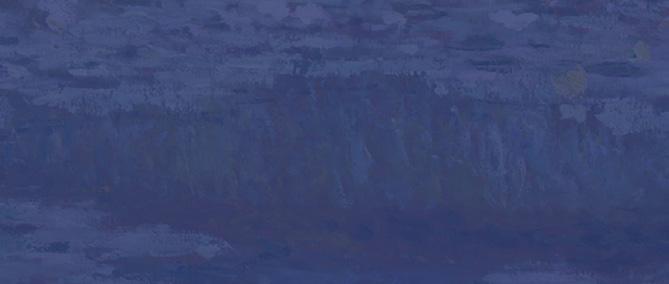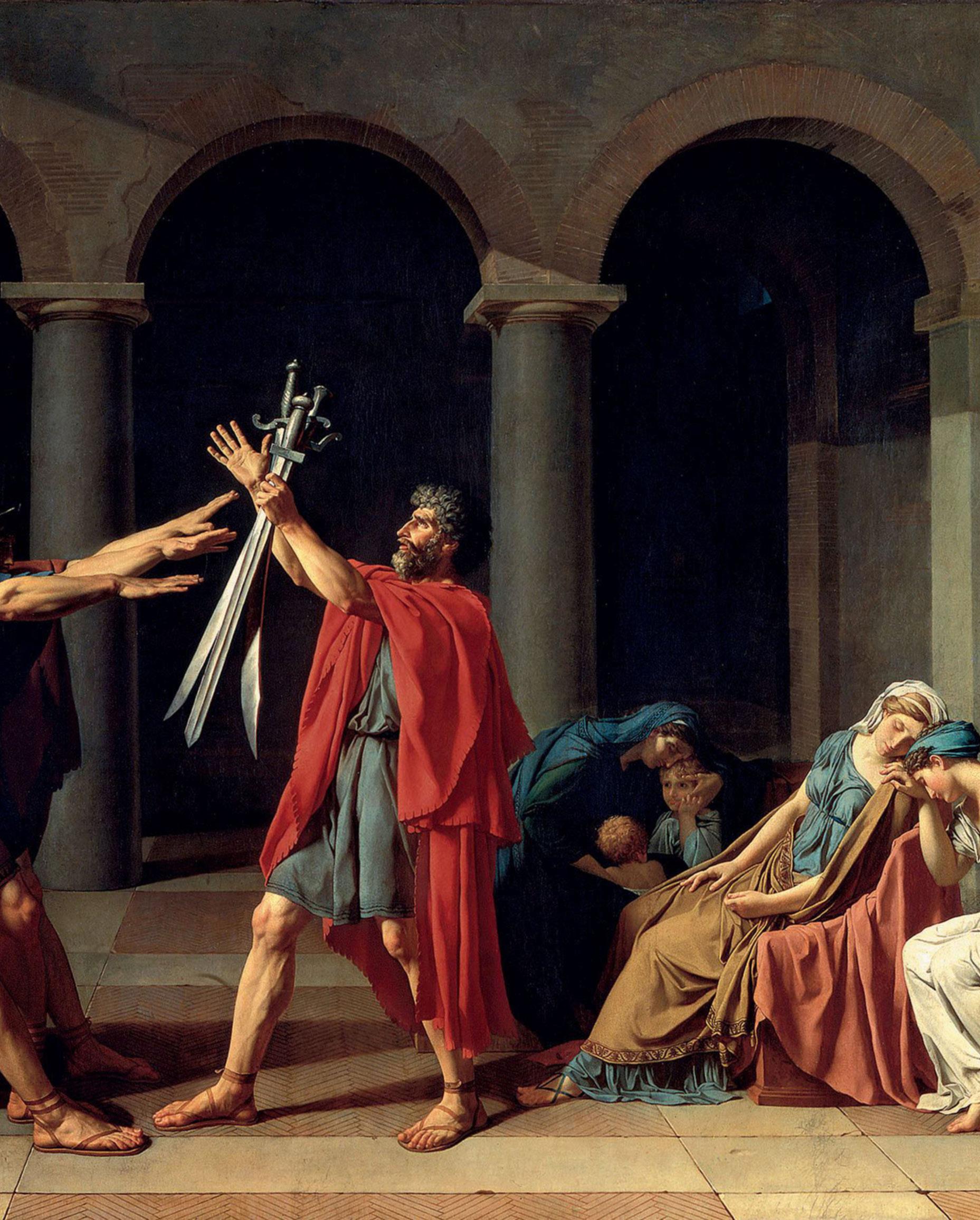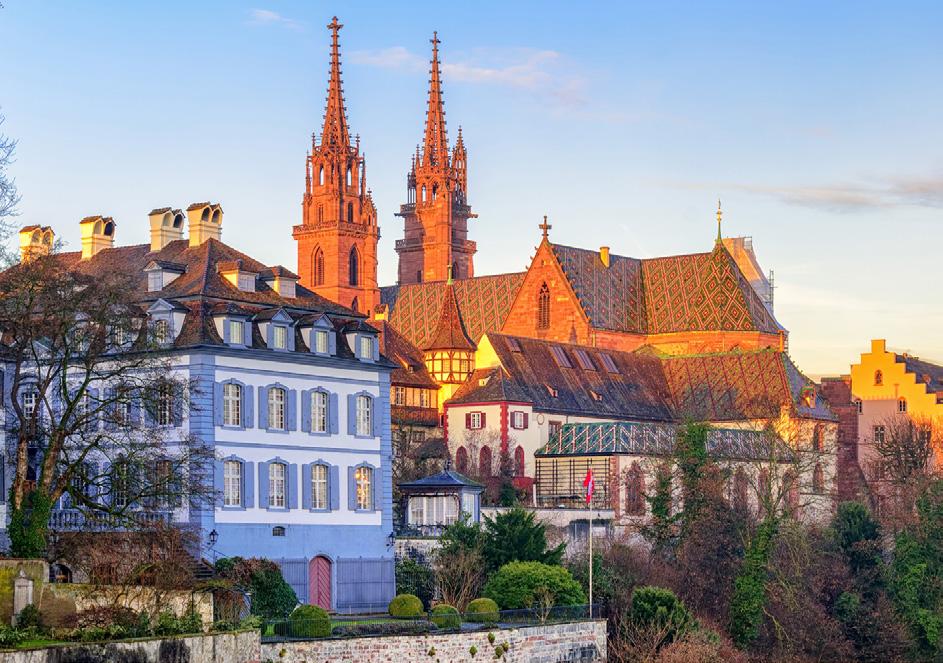LOUIS XIV’S POWERFUL ART INSTITUTIONS: THE ACADEMY & SALON
Art’s subject matter: historical, mythological or religious
Art’s technical rules: porcelain finish, muted colors and balanced composition
At this time, France was the epicenter of the art world, largely to the credit of French King Louis XIV, pictured here. Louis XIV, also known as Louis the Great or the Sun King, founded two powerful institutions: an art school called the French Royal Academy of Painting and Sculpture, and the Salon, where this art would exhibit.
Salons were held once, then eventually twice, per year. These juried shows could make or break an artist’s career. Indeed, the Academy set the standard for art in Europe during this time. The Academy furthered its stranglehold through highly prescribed rules, which delineated appropriate subject matter and technique. Artworks had to feature historical, mythological, or religious subject matter and convey a moral lesson.
In terms of technique, paintings needed to be highly finished with porcelainlike surfaces where no brushwork was visible. Colors were to be muted, and the composition had to be balanced, preferably through a triangular organization or other mathematical scheme. Make no mistake, if you were an artist in France during this time and did not follow the rules of Neoclassicism, you could not make a living.

Here we have a photograph of the Salon in 1903, depicting the Salon Jury judging artworks. This jury ultimately decided which pieces made it into a show and which did not. While the Academy prohibited other public art displays, by the turn of the 20th Century, alternative exhibitions began to be held regardless. These shows featured artists that had been denied entry to the Salon, where numbers began to dwindle given the harsh criteria for entry.


The most significant artist of the Neoclassical era was Jacques-Louis David, Napoleon’s court painter. This position allowed David a privileged role – even veto-power – regarding style and taste.

Shown here is David’s famous painting from 1784, Oath of the Horatii. Exemplifying all the requirements for neoclassical painting, its subject is historical, harkening back to antiquity and conveying a moral lesson: the three brothers depicted prepare to sacrifice their lives for the Roman Empire.
The figures are idealized, the surface is smooth, the colors are muted, and the composition is triangular and balanced.
Napoleon recognized the value of art as propaganda, an agenda most evident in the commissioned work, Napoleon Crossing the Alps, by David painted in 1801.
Here, David has gone to great lengths to portray Napoleon in the best possible light, including the rearing horse, whipping cape, pointing arm and Napoleon’s overall youthfulness. Even the color of Napoleon’s cape – gold, rather than red – was purposeful.
David has also embellished history: Napoleon did not in fact lead his army. In this instance he followed several days later after the troops’ advance. This example stands in stark contrast to the revolutions in art that were to come.

The first major revolution of Modern art we will identify here is the revolution of the line, otherwise known as Impressionism, pioneered by Claude Monet. In preceding periods of Western art history, the surface of any painting was meant to be completely smooth with no evidence of any brush strokes.
Monet’s work sought to capture the mood and atmosphere of a fleeting moment in time. He achieved this more painterly style through a technique called impasto, which used thick layers of paint. The impressionists also often worked en plein air – outside – rather than in the confines of a studio, as they were particularly fascinated by light.
CLAUDE MONET
Bridge over a Pond of Water Lilies, 1899

Demonstrating the stark differences between neoclassical and impressionist art, David’s painting has a highly finished surface with lines and proportions that are realistic. It also depicts a historical event. At the time, this was perfection – there were no competing artistic currents. Meanwhile, Monet broke each of these rules. Comparatively, his subject is mundane and he presents an uneven and seemingly-unfinished surface, using choppy lines. At first glance, this painting, called Impression, Sunrise, appears uncontroversial; however, it was produced at a time when the neoclassical tradition was dominant. Paintings such as this scandalized the art world.

In fact, the name “Impressionism” was borne from an insult when art critic Louis Leroy wrote in a French newspaper that this work looked more like a preliminary drawing. He remarked that a wallpaper pattern is more finished than this seascape and the painting looked like an impression, not a finished work of art.
Monet is one of Heather James Fine Art’s main preoccupations. There are thought to be just under 2,000 Monet paintings in existence, many of which are held by museums and are rarely deaccessioned. Interest in these and other high-quality artworks is increasing – especially as global wealth creation intensifies.

We have sold Monet’s 1885 painting Pots de Tulipes three times over the last 15 years. Monet has said that if it were not for flowers, he would never have become an artist.

Le Repos dans le Jardin, Argenteuil (1876) is the first Monet painting we sold about 18 years ago. We acquired this piece from the Metropolitan Museum in New York. An exquisite example of Impressionism, this piece depicts Monet’s wife, Camille, in a landscape outside a family home at Argenteuil.

Fragment de Nympheas (1915-1919) is one of Monet’s famous water lilly paintings, a scene from his pond at Giverny.


We sold this beautiful painting by Impressionist Alfred Sisley several years ago at auction. That sale is still one of the artist’s top auction records.

Baigneuse Assise (1913) is a portrait by PierreAuguste Renoir. This painting illustrates Renoir’s Impressionist credentials as well as his influence by Italian Renaissance masters.


Berthe Morisot worked closely with Manet, and artist who also greatly influenced the Impressionist movement. We sold this piece, Jeune Femme (1871) in 2012.
Mary Cassatt was a close associate of Edgar Degas. Depictions of a mother and child like this one are typical of her work. We sold this Cassatt painting, Jules Standing by His Mother (1901) in 2016.

The revolution of color, the second groundbreaking moment covered here, is more commonly known as Fauvism, a movement pioneered by Henri Matisse. The Fauvist painters were the first artists in the Western canon to use non-naturalistic color. Unbelievably, this innovation took place just over 100 years ago. Fauves allowed color to exist as an independent element, separate from its descriptive or representational purpose. Matisse, in particular, turned away from mixing paints and would often use paint straight from the tube.
Like the Impressionists, Fauvists adopted their name from an insult. This time, it was made by art critic Louis Vauxcelles, who saw the Fauvists’ exhibition at the controversial 1905 Autumn Salon and said that they paint like “wild beasts.” The term in French is fauves. The unnaturally-green skin color attracted repeated ridicule and viewers mocked that it appeared the subject had gangrene – or even worse, had died.
HENRI MATISSE
Madame Matisse (The Green Stripe), 1905


a bright scene in electrifying color.
 Maurice de Vlaminck’s House at Chatou (1905) is
Maurice de Vlaminck’s House at Chatou (1905) is
Another leader of the Fauvist movement, André Derain worked alongside Vlaminck and also very closely with Matisse. Derain’s take on London’s former Charing Cross Bridge includes a pink sky, yellow River Thames, and other dabs of bright color.


The revolution of the picture plane concerns the innovations of Pablo Picasso and Georges Braque, leaders in the development of Cubism.
PABLO PICASSO
Les Demoiselles d’Avignon, 1907


A great influence on Picasso’s groundbreaking work, and on an entire generation of artists, was the Post-Impressionist painter Paul Cézanne. In Cézanne’s Still Life with Basket of Apples (1890-94), we can observe one of his great innovations: allowing the viewer to see the table and apples from different angles at the same time. In reality, the objects in this painting would topple off the table. Cézanne altered the picture plane as the Fauvists manipulated color.

Picasso’s seminal Cubist work, Les Desmoiselles
D’Avignon (1907) is priceless. Like many great artists, Picasso drew inspiration from other sources and his predecessors, such as Cézanne’s innovations of multiple perspectives at once.

Here, we can also see direct adaptations of African masks in Picasso’s portraits. The Kifwebe mask and deformation mask both originate from the Songye people, a tribe based in the present-day Democratic Republic of Congo. The resemblance of Picasso’s portraits to these masks is obvious and intentional. This practice appears throughout the history of art: great artists fuse pre-existing imagery with their own experiences and perceptions of reality.





Cubism’s defining feature is to allow the viewer to see an object or scene from multiple perspectives at the same time. Picasso’s Dora Maar, Seated (1937) depicts one of Picasso’s lovers. Here you see her image from both the front and in profile at the same time – for example, one eye gazes forward while the other looks inward. Like Les Desmoiselles D’Avignon, this is one of Picasso most famous works and was executed thirty years after Cubism was realized. It is a spectacular example of Picasso implementing Cubist elements in a more Contemporary context.
Cubism’s manipulation of the picture plane broke 500 years of convention on perspective. Here, we see a church designed by Italian architect Brunelleschi, who was alive during the 15th Century and is widely considered to be the father of onepoint, or linear, perspective. Brunelleschi discovered that in a picture plane, parallel lines draw the viewer to one focus point, the vanishing point, on a lateral horizon line. Neoclassical artists and all successive realists rely on this canon to capture a scene as it exists in reality.



Contrast this linear perspective to any of Picasso’s Cubist works, which reject the use of a single picture plane and instead present the subject from multiple angles and multiple lights simultaneously. We have been fortunate to sell several Picassos, such as this 1913 Cubist masterpiece. Here, Picasso deconstructs several objects including a clarinet and violin.
Finally, Still Life With Red Lamp (1916-1918) by Spanish artist Maria Blanchard was inspired by the work of Picasso, Braque and others of the same school. This piece is an excellent example of her highly expressive and boldly colored cubist works.

For the fourth revolution, that of subject matter, we look to the abstract paintings of Wassily Kandinsky and Kazimir Malevich.
KAZIMIR MALEVICH
Suprematist Composition, 1916



Kandinsky’s Non-Objective (1910) and Malevich’s Suprematist Composition (1910) are both examples of early abstraction. The latter sold at auction in 2018 for $85.8 million. Like Matisse’s invention of non-representational color in painting, and Cezanne and Picasso’s work in multi-perspective, these abstract artists are unconcerned with any artistic precedent of representing discernible forms.
Malevich, who was known as a Suprematist, was intrigued by the search for art’s barest essentials. Kandinsky, on the other hand, believed that total abstraction allowed transcendental expression of human emotions. This groundbreaking movement began only a century ago around 1910. In doing so, early abstract painters like Malevich and Kandinsky paved the way for some of the Post-War period’s greatest artists.
The following examples come from recognizable artists whose work is indebted to these innovators.


Mark Rothko, was an American painter who emigrated from Russia at the age of 10. His color-fields are immediately recognizable. This piece from 1950, previously owned by David Rockefeller, was purchased at a 2007 auction by a member of Qatar’s royal family. It sold for $72.8 million.
Willem de Kooning’s Interchange (1955) sold for an incredible $300 million dollars in 2015 in a private sale.


The same collector purchased this Jackson Pollock painting, Number 17A, for $200 million.

Together, Rothko, de Kooning and Pollock represent a movement known as Abstract Expressionism, an important successor to early Abstraction.
Unlike their immediate predecessors who were concerned with external and universal truths, these later artists made art as an expression of their own inner world of emotion. Thus, their name: abstract expressionists.
Works by female artists such as Helen Frankenthaler are some of the market’s most sought-after works at present, following decades of their art being undervalued.

We are also witnessing a market correction for other demographics, including African American and other minority artists.
We sold this painting by Frankenthaler in early 2018.


Finally, the dynamic and complex No Room at the End (1977) exemplifies the work of Joan Mitchell, another foremost Abstract Expressionist artist.

Our last revolution questions the very definition of art and what constitutes an artwork. This artistic and literary movement was known as Dada, and it rejected any notion of artistic “rules.” Rather, it upheld spontaneity in the artistic process. The idea behind a work of art was more important than the piece’s technical attributes.
In short, Dada was certainly not about pleasing the viewer. Rather, it sought to upend bourgeois taste while destroying existing artistic dogma. Think back to the conformity of the Paris Salon; nothing could be further from its values than Dada.
Pictured here is Marcel Duchamp’s Fountain, from 1917. Duchamp referred to this as a “ready-made” object, in other words a manufactured object repurposed as art. Duchamp obtained the urinal from a plumbing manufacturing company called J.L. Mott Iron Works. Then, he simply turned the urinal upside down, signed and dated it, placed it on a pedestal at a New York exhibition, and declared it art. Can you imagine the public’s reaction at the time? In 2004, Fountain was declared the most influential artwork of the 20th Century by a panel of 500 art experts. Indeed, Duchamp’s influence on contemporary art cannot be overstated.
MARCEL DUCHAMP Fountain, 1917







The Bride Stripped Bare, which stands 9 feet high, shows the types of found objects Duchamp repurposed to create his work – all between two panes of glass. Duchamp did not declare the work “finished” until the glass accidentally shattered.

German Dadaist Max Ernst, like the rest of his school, was influenced by the horrors of World War I, as evident in this collage, Murdering Airplane, from 1920.

This work is by Man Ray, an American who spent much of his life in Paris. His composition includes found kitchen objects – a fork and knife.


The following pages provide a glimpse into the breadth of Post-War and Contemporary artists inspired by Dada. Most art that we see today, and that would later be called “unconventional,” is a derivative of Duchamp and his contemporaries.
For example, here we have Andy Warhol’s Brillo Box. By transforming a common household item into a sculpture, Warhol returns to Duchamp’s question: “What is art?”
This series that American artist Jeff Koons exhibited throughout the 1980s features hoovers, or vacuum cleaners.
Unlike Warhol’s Brillo Box, which the artist fabricated himself, Jeff Koons uses found objects as Duchamp did in Fountain. Both explore themes of consumerism and advertising, harkening to Dada’s interest in mass culture.



Jeff Koons’s whimsical balloon animals, which the artist creates out of stainless-steel, have become a symbol of pop culture in and of themselves.
The sculptures can now be found around the world. Balloon Dog (Pink) was installed at Versailles in 2008, and Balloon Dog (Orange) was part of a performance by music artist Jay-Z in 2017.


One of the best-known names in Contemporary art is Damien Hirst. This recognizable piece incorporates a real tiger shark. Hirst has produced similar works with other animals, including cows and deer.
Hirst was recently quoted as saying he wants to create art that no one can ignore, a statement which relates directly back to Duchamp’s ability –purposeful or otherwise – to affect the viewer.


Tracy Emin’s My Bed conveys a period of depression when the artist was unable to leave her bed. True to a core Dada tenet, here Emin’s idea matters more than the artwork’s presentation.




In what became a prominent news story, Banksy’s Girl With Balloon self-destructed as its auction sale closed in October 2018. Banksy is a British street artist, known for his use of satire and often intense societal critique.
The anonymous buyer, who paid 1.4 million pounds for the painting, had an interesting reaction to the incident. She said,”When the hammer came down last week and the work was shredded, I was at first shocked, but gradually I began to realize that I would end up with my own piece of art history.”

True to these remarks, history was made: Girl With Balloon was the first example of art creation at auction. In doing so, Banksy carved his own place in our lineage of artistic innovators. Banksy installed the shredder after the work’s creation within the frame in the hopes it would come up for sale. Captioning his Instagram post about the incident, Banksy quoted Picasso: “The urge to destroy is also a creative urge.”
The shredding echoes Dada in the spontaneity of this artistic moment. More than that, in its poking fun at – or questioning of – the existing art establishment, the shredding recreates the spirit of every revolution covered here.

Looking into the future, we can only speculate where the visual arts might go. Is there a new Revolution on the way? Or are we in the middle of one right now?
It is difficult to assess. A recent sale by Christie’s in November 2018 may point to one potential revolution. In this sale, the auction house sold a very unique artwork for over four hundred thousand dollars, shattering its ten-thousanddollar estimate.

Who was the artist? It was AI--artificial intelligence. This piece is called Portrait of Edmond de Belamy. A Paris based art group named Obvious explored the fields of art and artificial intelligence by using a set of algorithms. Their system goes by the acronym GAN, which stands for “generative adversarial network.” GAN fed their system a data set of 15,000 portraits painted between the 14th and 20th centuries. The generator’s output resulted in this image.
This is just one example of where the art world may be headed. Could this be the next historic revolution?



























 RAPHAEL The School of Athens, 1509-11
PABLO PICASSO Cat Catching the Bird, 1939
CLAUDE MONET Impression, Sunrise, 1872
RAPHAEL The School of Athens, 1509-11
PABLO PICASSO Cat Catching the Bird, 1939
CLAUDE MONET Impression, Sunrise, 1872









 JACQUES-LOUIS DAVID
JACQUES-LOUIS DAVID




















 Maurice de Vlaminck’s House at Chatou (1905) is
Maurice de Vlaminck’s House at Chatou (1905) is































































